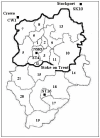A proposed approach in defining population-based rates of major injury from a trauma registry dataset: delineation of hospital catchment areas (I)
- PMID: 18402693
- PMCID: PMC2365946
- DOI: 10.1186/1472-6963-8-80
A proposed approach in defining population-based rates of major injury from a trauma registry dataset: delineation of hospital catchment areas (I)
Abstract
Background: Determining population-based rates for major injury poses methodological challenges. We used hospital discharge data over a 10-year period (1996-2005) from a national trauma registry, the Trauma Audit and Research Network (TARN) Manchester, to construct valid numerators and denominators so that we can calculate population-based rates of major injury in the future.
Methods: We examined data from all hospitals reporting to TARN for continuity of numerator reporting; rates of completeness for patient postcodes, and clear denominator populations. We defined local market areas (>70% of patients originating from the same postcode district as the hospital). For relevant hospitals we assessed data quality: consistency of reporting, completeness of patient postcodes and for one selected hospital, North Staffordshire Royal Infirmary (NSRI), the capture rate of numerator data reporting. We used an established method based on patient flow to delineate market areas from hospitals discharges. We then assessed the potential competitors, and characterized these denominator areas. Finally we performed a denominator sensitivity analysis using a patient origin matrix based on Hospital Episodes Statistics (HES) to validate our approach.
Results: Sixteen hospitals met the data quality and patient flow criteria for numerator and denominator data, representing 12 hospital catchment areas across England. Data quality issues included fluctuations numbers of reported cases and poor completion of postcodes for some years. We found an overall numerator capture rate of 83.5% for the NSRI. In total we used 40,543 admissions to delineate hospital catchment areas. An average of 3.5 potential hospital competitors and 15.2 postcode districts per area were obtained. The patient origin matrix for NSRI confirmed the accuracy of the denominator/hospital catchment area from the patient flow analysis.
Conclusion: Large national trauma registries, including TARN, hold suitable data for determining population-based injury rates. Patient postcodes from hospital discharge allow identification of denominator populations using a market area approach.
Figures
References
-
- British Medical Association Injury prevention London. 2001.
-
- Secretary of State for Health Saving Lives: Our Healthier Nation London. 1999.
-
- Office for National Statistics Mortality Statistics: Injury and Poisoning 2003 Series DH4 No 28 London. 2005.
-
- Office for National Statistics Health Inequalities Decennial Supplement Series DS No15 London. 1997.
-
- Office for National Statistics Health Survey for England 1995 Series no 5 London. 1997.
Publication types
MeSH terms
LinkOut - more resources
Full Text Sources
Medical
Miscellaneous


